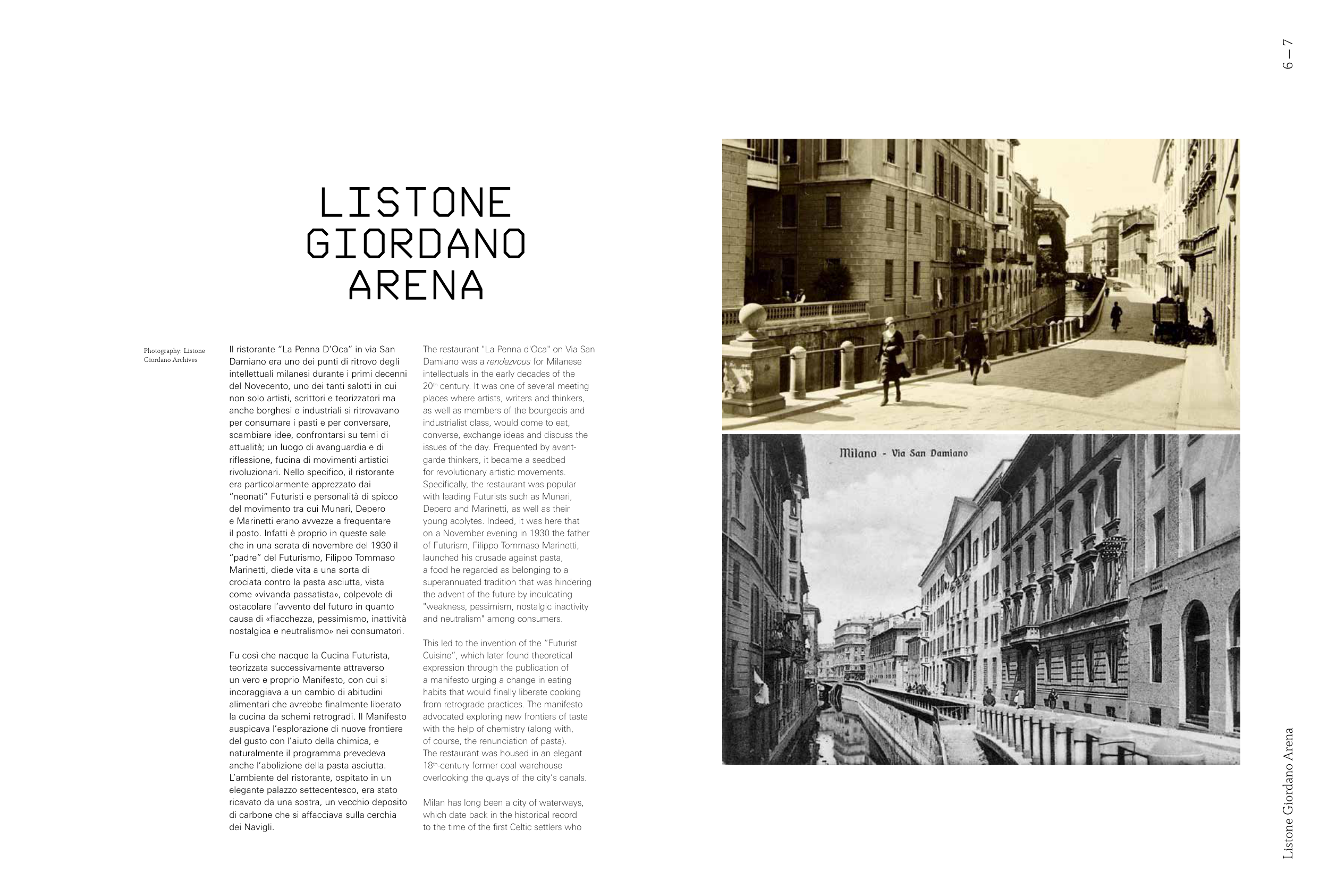6 — 7
Listone Giordano Arena
Il ristorante “La Penna D’Oca” in via San
Damiano era uno dei punti di ritrovo degli
intellettuali milanesi durante i primi decenni
del Novecento, uno dei tanti salotti in cui
non solo artisti, scrittori e teorizzatori ma
anche borghesi e industriali si ritrovavano
per consumare i pasti e per conversare,
scambiare idee, confrontarsi su temi di
attualità; un luogo di avanguardia e di
riflessione, fucina di movimenti artistici
rivoluzionari. Nello specifico, il ristorante
era particolarmente apprezzato dai
“neonati” Futuristi e personalità di spicco
del movimento tra cui Munari, Depero
e Marinetti erano avvezze a frequentare
il posto. Infatti è proprio in queste sale
che in una serata di novembre del 1930 il
“padre” del Futurismo, Filippo Tommaso
Marinetti, diede vita a una sorta di
crociata contro la pasta asciutta, vista
come «vivanda passatista», colpevole di
ostacolare l’avvento del futuro in quanto
causa di «fiacchezza, pessimismo, inattività
nostalgica e neutralismo» nei consumatori.
Fu così che nacque la Cucina Futurista,
teorizzata successivamente attraverso
un vero e proprio Manifesto, con cui si
incoraggiava a un cambio di abitudini
alimentari che avrebbe finalmente liberato
la cucina da schemi retrogradi. Il Manifesto
auspicava l’esplorazione di nuove frontiere
del gusto con l’aiuto della chimica, e
naturalmente il programma prevedeva
anche l’abolizione della pasta asciutta.
L’ambiente del ristorante, ospitato in un
elegante palazzo settecentesco, era stato
ricavato da una sostra, un vecchio deposito
di carbone che si affacciava sulla cerchia
dei Navigli.
The restaurant "La Penna d'Oca" on Via San
Damiano was a rendezvous for Milanese
intellectuals in the early decades of the
20th century. It was one of several meeting
places where artists, writers and thinkers,
as well as members of the bourgeois and
industrialist class, would come to eat,
converse, exchange ideas and discuss the
issues of the day. Frequented by avant-
garde thinkers, it became a seedbed
for revolutionary artistic movements.
Specifically, the restaurant was popular
with leading Futurists such as Munari,
Depero and Marinetti, as well as their
young acolytes. Indeed, it was here that
on a November evening in 1930 the father
of Futurism, Filippo Tommaso Marinetti,
launched his crusade against pasta,
a food he regarded as belonging to a
superannuated tradition that was hindering
the advent of the future by inculcating
"weakness, pessimism, nostalgic inactivity
and neutralism" among consumers.
This led to the invention of the “Futurist
Cuisine”, which later found theoretical
expression through the publication of
a manifesto urging a change in eating
habits that would finally liberate cooking
from retrograde practices. The manifesto
advocated exploring new frontiers of taste
with the help of chemistry (along with,
of course, the renunciation of pasta).
The restaurant was housed in an elegant
18th-century former coal warehouse
overlooking the quays of the city’s canals.
Milan has long been a city of waterways,
which date back in the historical record
to the time of the first Celtic settlers who
LISTONE
GIORDANO
ARENA
Photography: Listone
Giordano Archives


